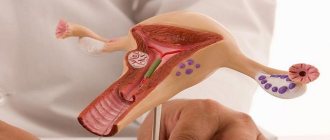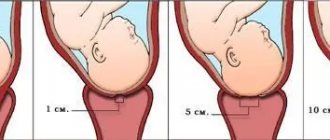Women use natural methods to determine ovulation. Some authors of home examination methods additionally recommend determining the position of the cervix and its consistency. It can be hard, medium hard and soft. The position in the vagina is also important - high, medium or low.
Yes, but it all depends on the length of the vagina. Average anatomical indicators are from 7 to 12 cm. In an upright position of the body, the vagina bends slightly in the upper part. The middle finger is the longest - usually 7-8 cm.
- How to feel the cervix if the vagina is long?
To do this, it is recommended to conduct the examination in a squatting position, or on the edge of a chair, in the bathroom. You can bend one leg at the knee, placing it on a chair. In this position, the organ approaches the vestibule of the vagina. The cervix will be at its farthest base. To the touch it is normally moist, smooth, spherical in shape, slightly protruding into the vaginal cavity, harder than the adjacent tissues.
- Can a finger hurt the cervix?
Yes, if the woman has long nails. The epithelium of the organ is easily injured. Especially with dysplasia of varying degrees. A woman may not feel that she has caused herself a micro injury or a scratch. This will be enough for bacteria, and an inflammatory process will develop. During examination, nails should be cut short and have smooth edges.
- What are the ground rules?
Hands should be washed thoroughly with soap. To facilitate finger insertion, use only water-based intimate lubricants. Do not use conventional fat or oil based creams. This is a breeding ground for microorganisms.
- Can you feel the uterus with your finger?
Without certain skills it will be difficult to do this. Only the cervix is located in the vagina. The uterus itself is located in the pelvic area. Gynecologists use a two-handed palpation method to determine the tone of the organ, determining the early stages of pregnancy or its absence. To do this, two fingers are inserted into the vagina, and the fingers of the other hand press on the stomach above the pubic bone. In this case, the uterus can be felt on the anterior vaginal vault as a rounded muscular compaction.
It is important to remember : you cannot conduct an independent examination by palpation of female internal organs if there are signs of inflammation - unusual discharge, pain. You should definitely contact a gynecologist.
Yes, but it all depends on the length of the vagina. Average anatomical indicators are from 7 to 12 cm. In an upright position of the body, the vagina bends slightly in the upper part. The middle finger is the longest - usually 7-8 cm.
The process of delivering a pregnancy is interesting to every expectant mother. Most multiparous women already have an idea of what they will have to face. Newly-made mothers-to-be are in a state of excitement and uncertainty before giving birth. In order for the baby to appear according to all the rules and naturally, the woman must be fully pregnant. It is this process that will be discussed in the article. You will learn the main stages and timing of the transformation of the cervical canal. You can also find out what it means when the cervix is dilated by 1 finger.
A woman's uterus is a unique and very interesting organ. Inside, it is lined with a mucous membrane, which constantly changes during the menstrual cycle. With the onset of conception, this so-called pouch becomes the place where the fetus grows and develops.
The uterus consists of several parts. At the very beginning it has an entrance, which is called the internal pharynx. A tube comes out of it. This segment ends with another mouth, only this time external. This opening is the cervix. It is already located in the woman’s vagina. It is there that the future baby passes during childbirth.
Cervical dilatation
Immediately before the birth of the baby, an increased expansion of the cervical canal occurs. Most often, this process is carried out between the 36th and 42nd weeks of pregnancy. However, in some cases, premature dilatation of the cervix occurs. You will learn about it in more detail below.
A slight expansion of the cervical canal is facilitated by training contractions. During them, the woman feels tension in the front wall of the abdomen. The uterus becomes very hard and presses on the bottom. In most cases, such sensations do not pose any threat to the life of the child and the condition of the expectant mother. However, if training contractions appear more than four times in an hour, then you should notify your doctor about this.
How is the cervix dilated before childbirth? This process may occur in several stages. Let's consider how the expansion of the cervical canal is carried out (stages and timing).
Second stage: fast
During this period, the woman should already be in the maternity hospital. Only in a medical institution can specialists sensibly assess the condition of a woman in labor and, if necessary, provide her with timely assistance. Contractions during rapid dilatation of the cervix are already quite painful. They are noted at intervals of one or two minutes. In this case, the duration of contraction of the reproductive organ can be approximately 3-5 minutes.
The speed at this stage is one centimeter per hour. However, these data can be considered conditional. Each woman’s body is individual, and the process can proceed completely differently.
Why is it dangerous if done incorrectly?
If a woman makes too sudden movements during palpation, or does it under tension, then negative consequences are possible.
- soreness;
- bleeding;
- uterine tone;
- miscarriage.
If, after a self-examination, a pregnant woman feels discomfort that turns into cramping pain, there is a danger of tone or even spontaneous abortion (miscarriage). If bleeding or prolonged pain occurs, you must be hospitalized immediately, otherwise you risk losing the baby. Only timely assistance from medical workers will save the baby.
To avoid such unforeseen consequences, it is advisable not to do any examinations at home yourself. A more accurate and safe option is an examination by an obstetrician-gynecologist in a gynecological office.
Dilatation of the cervix by 1 finger: when to give birth?
Many representatives of the fairer sex who are preparing to become mothers hear a similar diagnosis. What does it mean?
Gynecologists and obstetricians always measure the dilation of the cervical canal in their fingers. Full opening of the reproductive organ creates a hole of 10 centimeters. One finger is equal to approximately two centimeters. If you have the position of the cervix described above, then you can assume that the opening in the cervical canal has reached approximately 2 cm. When can you expect the onset of labor? It all depends on the woman’s body. Let's look at a few popular situations.
Labor will begin in a few hours
If the expectant mother has a one-centimeter dilatation of the cervical canal, then labor may well begin within a few hours. In this case, the position of the cervix must also be taken into account. It should be straight. It is also necessary to determine the length of the cervical canal. This distance does not exceed one centimeter. If these indicators are distinctive, then, most likely, the woman is not yet fully ready for the birth of a baby.
How many days after conception is it possible to determine
The timing of determining that pregnancy has occurred depends on the detection method used. The most informative and accurate methods are:
- Blood test for hCG. The level of this hormone in the blood increases just a couple of days after the fertilized egg has successfully implanted in the uterus.
- Ultrasonography. The amniotic egg is visualized on the ultrasound machine screen 1-2 weeks after conception.
- Pregnancy test. The cherished two stripes appear on quality tests already from the first day of missed menstruation, that is, approximately two weeks after the expected conception.
Using any of the above methods for determining pregnancy gives almost one hundred percent confidence that conception has occurred. The remaining signs are indirect and may either not appear at all or be caused by other reasons.
This symptom does not only appear during pregnancy. Breasts may swell and increase in size during premenstrual syndrome. A woman feels heaviness and pain from touching the mammary glands. Nipple sensitivity may increase.
Delay, negative test...
When to take a pregnancy test?
Intrauterine device
Moms and future mothers, tell us who knows what about this, how did it go for you? There's still a week until my period, but I want to find out sooner
Unfortunately, I haven’t acquired any fat, somehow I don’t have enough time (((
How to feel the uterus during pregnancy? Usually, it is by feeling the uterus that it is possible to determine whether the girl is in position. In general, pregnancy can be determined at fairly early stages due to suggestive and reliable signs. Many external signs of an “interesting situation” were learned to be recognized in ancient times, but even today they remain quite relevant. It goes without saying that almost all of them relate to speculative, probable signs.
Can a finger deflower a girl or girl?
During consultations, young girls periodically ask questions: “Is it possible to insert a thick finger into the vagina? What happens if you insert or smear sperm into your vagina with your finger? What to do if you put a fat penis in your vagina? Is it possible to get pregnant? Here are the answers to these questions.
1. Is it possible to put a finger in a virgin’s vagina? It's possible, but why? When inserting or inserting a finger, you can easily damage the hymen. If you really want to insert it, then this must be done extremely carefully so as not to damage the hymen. If the hymen is damaged, a virgin girl loses her virginity in a stupid way.
2. What happens if you insert or smear sperm into the vagina with your fingers. In this case, the probability of getting pregnant is almost the same as if a man inserted his penis inside the vagina and came there.
3. Are there girls who stick their fingers in their holes? Yes, such girls exist.
4. What happens if you insert 2 fingers into a girl’s virgin vagina. Then most likely the girl will lose her virginity.
5. What happens if you caress the vagina with your finger. If only the clitoral area is stimulated, then the girl will not lose her virginity, but if the entrance to the vagina (hole) is stimulated, then there is a very high risk of losing her virginity.
6. How many fingers can you put into your vagina? You can put 2, and 3, and 4, then in this case the girl will definitely become a woman, since she will lose her hymen.
7. What happens if you insert a penis and fingers into the vagina. The answer is deflowering.
8. If you stick your finger out of the vagina and there is blood, what does this mean? Perhaps you had your period the day before. If there was hard sex, and 2 penises penetrated at the same time, then there may be a slight rupture of the vagina.
9. Does the vagina hurt when spread with fingers? No.
10. Can you get infected if you insert a dirty finger into the vagina during masturbation? Vaginitis, an inflammation of the vagina, may occur. Hence the conclusion: you can’t stick your dirty fingers anywhere.
11. Is massage of the vagina with your fingers pleasant? Yes.
12. Is it possible to damage the vagina with a finger? Yes, if you have long nails.
13. Can HIV, hepatitis B, C occur if a sick person inserts a finger into a virgin’s vagina? Yes, if there are microcracks on the surface of the finger.
14. What to do with your fingers in the vagina? Light gentle massaging movements and stimulation of the anterior wall immediately after entry – the G point.
15. When does a guy insert his fingers into his girlfriend's vagina? During foreplay for better arousal.
16. How to move a finger into the vagina? Affectionately, gently, changing the rhythm and depth of penetration.
17. Where to go if a finger in the vagina rests on a formation. Contact your gynecologist.
18. Will 3 fingers fit in the vagina? Yes. But a virgin will cease to be a virgin.
19. Is it possible to get an infection into the vagina with your fingers? Yes.
20. Is it possible to expand a girl’s vagina with a finger? No.
21. What to do if a guy puts his fingers into the vagina without first washing them. Ask him to wash his hands with soap.
22. What does a finger feel like in the vagina? Soft wet walls.
23. Will 4 fingers fit into the vagina? As developed - yes.
24. Caressing the vagina with the tongue and fingers is beneficial. With regular sex life, yes.
25. Is it possible to insert sperm into the vagina with a finger? Of course, if your finger is covered in sperm.
Is it possible to feel the cervix when washing?
Sometimes women think they can feel their cervix when they wash their hair. In a normal state, this is impossible, because the cervix is deep enough and in order to feel it, you need to try. If you wash not only the external genitalia, but also your fingers in the vagina, while sitting on the toilet, you can feel it. In our age of physical inactivity and disturbances in the production of hormones, women suffer from weak sexual constitution. Therefore, often after a difficult birth and excessive physical exertion, a common pathology can occur - this is prolapse and prolapse of the cervix.
To prevent the disease it is necessary:
- train intimate muscles with an educated trainer;
- monitor hormonal levels
- avoid heavy physical activity
- take vitamins.
Thus, learning to determine the condition of the cervix at home is quite possible. Whatever it is, self-diagnosis is not a substitute for visiting an experienced doctor. Therefore, get checked regularly by a trustworthy gynecologist.
The doctor prescribed vaginal tablets for dysbiosis, nothing special. Today I took one pill and felt some kind of lump in my vagina, only the length of my middle finger. Is this uterine prolapse? What could this be connected with, nothing like this was there before
Find out the opinion of an expert on your topic
Slobodyanik Marina Valerievna
Psychologist. Specialist from the site b17.ru
Nikulina Marina
Psychologist. Specialist from the site b17.ru
Sheludyakov Sergey
Psychologist, Clinical psychologist. Specialist from the site b17.ru
Trifonova Maria Anatolyevna
Psychologist. Specialist from the site b17.ru
Gundertailo Yulia Danilovna
Psychologist. Specialist from the site b17.ru
Vyacheslav Potapov
Psychologist, consultant. Specialist from the site b17.ru
Zinovieva Natalya Yurievna
Psychologist. Specialist from the site b17.ru
Wrzecinska Eva
Psychologist. Specialist from the site b17.ru
Natalya Maratovna Rozhnova
Psychologist. Specialist from the site b17.ru
24. Caressing the vagina with the tongue and fingers is beneficial. With regular sex life, yes.
The process of delivering a pregnancy is interesting to every expectant mother. Most multiparous women already have an idea of what they will have to face. Newly-made mothers-to-be are in a state of excitement and uncertainty before giving birth. In order for the baby to appear according to all the rules and naturally, the woman’s cervix must be fully dilated. It is this process that will be discussed in the article. You will learn the main stages and timing of the transformation of the cervical canal. You can also find out what it means when the cervix is dilated by 1 finger.
“In the early stages, we try to touch the uterus as little as possible”
Author:
Reznik Irina
7 minutes
3273
The best period in a woman’s life, when she is expecting a child, is overshadowed in half of the cases by toxicosis, and in 12-15% by the threat of miscarriage. What determines the successful course of pregnancy, what complications threaten it, how to minimize them and give birth to a healthy baby at term, the chief physician of the Moscow City Hospital named after. V.V. Vinogradova, obstetrician-gynecologist, MD. Olga Sharapova.
Olga Viktorovna, what does a successful pregnancy depend on?
- First of all, on the health of the woman herself, the presence of somatic diseases, gynecological and, no less important, mental. Only a healthy woman can go out and give birth to a healthy child. It is often during pregnancy that young women are diagnosed with some kind of congenital developmental anomalies, heart or kidney disease, or diabetes mellitus.
In second place we can put the age of the woman. The younger she is, the fewer diseases she has, and the pregnancy is easier. Obstetric history is very important - the number of previous pregnancies and births, how they proceeded and how they ended. We always calculate which risk group a woman may fall into. That is, the more pregnancies that end in abortion or miscarriage, the higher the risk for the next pregnancy. Today it is possible to prevent many complications, but it is important to conduct timely research and take measures aimed at maintaining the health of the pregnant woman and pregnancy.
Has the health of modern women who have entered reproductive age changed in any way compared to their mothers and grandmothers?
“The number of diseases itself has not changed, but today we have the opportunity to thoroughly examine patients. Medicine has made dramatic progress over the past 3-5 years; new, more advanced diagnostic research methods have emerged that make it possible to identify all somatic and genetic pathologies at the preclinical level.
Another thing is that the age of first-time mothers has increased. If previously the first birth occurred before the age of 25, now it is at 25-30 years. Today, women first strive to get a good education, a job, some material benefits, and only after that do they get married and have children. In the West, this happened earlier, but in our country the diagnosis of “primipara older women after 30 years” appeared not so long ago - 3-5 years ago.
Moreover, there is a tendency towards an increase in the age of the pregnant woman, the so-called “birth after 40”. The advantages of a later pregnancy include the fact that it occurs planned and consciously. At this age, a woman, as a rule, responsibly prepares for the conception and birth of a child. The disadvantages are the risk of chromosomal abnormalities in the fetus, especially high in women over 40 years of age. Such patients more often develop complications during pregnancy and childbirth, among them the percentage of surgical delivery is higher.
What are the most common pregnancy pathologies?
— Almost every second woman experiences nausea and vomiting during pregnancy. These are physiological changes that are not a complication as such. But when changes appear in urine and blood tests, decompensation occurs in the body. If a woman has uncontrollable vomiting and cannot take any food, then this complication is early toxicosis, which must be treated in a hospital.
In second place among complications of pregnancy is the threat of termination in the early stages, up to 12 weeks. According to statistics, up to 20% of all pregnant women experience this. At later stages, preeclampsia (a condition in which hypertension develops and damage to the nervous system, liver, and kidneys) and eclampsia - the maximum severity of preeclampsia - come first. This is a serious disease that occurs only during pregnancy and ranks first among the causes of maternal mortality. Premature birth ranks fourth among all pregnancy complications - it occurs in approximately 4.5% of cases.
Why is there a threat of miscarriage? And how real is it?
— The threat of abortion itself occurs in 15%. And if left untreated, about 5% have miscarriages. Therefore, if you feel something is wrong, a woman should contact a specialist. At the same time, the real threat of miscarriage is determined not only by clinical symptoms, but also by diagnostic methods. The doctor looks to see if there is any discharge, and what kind, and performs an ultrasound examination. If an ultrasound reveals that the length of the cervix is less than three centimeters, then the threat of termination of pregnancy is real, and the woman is hospitalized in a hospital. First of all, uterine spasms are relieved, for which antispasmodic drugs are used.
Increased uterine tone may be due to some genetic diseases, problems with the cervix or fetal pathology. But more often, so-called false uterine tone occurs, when a woman makes a diagnosis of “threatened miscarriage” herself because she has a stomach ache, for example, because she has not had a bowel movement for several days. Or, let’s say, she felt pain when urinating - perhaps it’s cystitis, which, of course, needs to be treated so as not to provoke a threat of termination of pregnancy.
In what cases is it impossible to maintain a pregnancy?
— In the early stages, the main causes of miscarriage are dishormonal disorders of various types.
At later stages - various infectious diseases that lead to the development of various abnormalities of fetal development, hypoxia (oxygen deficiency), and dysfunction of the placenta. Therefore, all pregnant women are examined for the presence of infectious diseases: toxoplasmosis, cytomegalovirus, herpes and others. It turns out what kind of infections they are - chronic or acute. Only acute processes are treated during pregnancy. For example, approximately 40% of our female population are carriers of the herpes simplex virus. But if this virus has become active, treatment must be prescribed.
Anomalies in the development of the genitourinary organs, gynecological diseases such as uterine fibroids, endometriosis and others can cause miscarriage. In these cases, conservation therapy is prescribed in a hospital setting.
What should we do about the statements of some gynecologists that there are no real means of preserving pregnancy and that treating the threat of miscarriage is simply a profanity that came to us from Soviet times?
— Indeed, some experts believe that treating threatened miscarriage in the early stages does not make sense, since natural selection occurs. But, despite this, every woman has the right to maintain her pregnancy and a healthy child. And all currently existing clinical protocols, recommendations and orders of the Ministry of Health of the Russian Federation for the management of pregnancy, childbirth and the postpartum period are aimed at providing specialized high-tech care to a woman and her child.
Moreover, if previously it was believed that pregnancy and childbirth are contraindicated in case of heart disease, kidney disease, or oncology, and doctors suggested terminating the pregnancy, now there are no such guidelines. The main thing is for the woman to see a doctor as soon as possible, undergo an examination, and begin corrective treatment, which will prevent possible complications in the future. Today we have at our disposal a sufficient arsenal of medications that can be used at different stages of pregnancy.
The current standard of examination of pregnant women is much broader than ten years ago. But still, how sufficient is it or is there any point in carrying out some additional examinations?
— The current standard allows us to calculate the main risks that are possible during pregnancy and childbirth. But, of course, there are still certain additional studies that are prescribed to specific women, according to indications. Let's say a blood test for hemostasis, violation of which can cause high blood pressure, edema, proteinuria (the presence of protein in the urine).
If a woman’s previous pregnancies have had complications, she is prescribed additional tests that are not included in the standard of pregnancy management—blood tests for genetic mutations. There is, for example, the so-called Leiden mutation, which can cause premature birth or severe forms of eclampsia. In this case, during pregnancy, a woman is prescribed drugs that improve blood rheology and blood flow in the uteroplacental complex to prevent fetal malnutrition.
But, I repeat, any additional studies are prescribed if there were complications in a previous pregnancy. If a woman registers for the first time, of course, no one will prescribe her anything that is not included in the standard of pregnancy management. And there is no point in doing this on your own.
It’s another matter if the woman herself has some kind of pathology. For example, in our maternity hospital, women with cardiovascular pathology undergo echocardiography. Unlike an ECG of the heart, this gives us a complete picture of possible heart disease in order to avoid risks during childbirth or cesarean section. If a woman has severe headaches or has had some kind of head injury, then we try to do an MRI or CT scan of the brain - to understand whether there is a tumor process or some pathological vascular plexuses (the so-called malformation of cerebral vessels) that can lead to hemorrhage during childbirth. It is very important to sort this out before giving birth, because during the pushing period, different situations are possible if the blood vessels are not positioned correctly.
According to the standard, ultrasound is performed several times during pregnancy. But some refuse this research, considering it dangerous for the child.
— Ultrasound examinations are absolutely harmless at any stage of pregnancy. Another thing is that in the early stages we try to touch the uterus as little as possible, because any pressure or pressure with a sensor can cause spontaneous contraction of the muscles of the uterus. By order of the Russian Ministry of Health, ultrasound examinations are carried out three times during pregnancy, this is quite enough. In case of complications, of course, ultrasound is prescribed more often.
Where is the best place to be monitored during pregnancy?
— You need to be observed by good professionals, because the most important thing is the qualifications of an obstetrician-gynecologist. Whether he works in a private or public clinic does not matter.
Many pregnant women do not stop working until after giving birth. Is it dangerous?
— Maternity leave is given to a woman for a reason - this is the period of time that you need to devote to your health and relax. Especially if work is associated with physical or psycho-emotional stress, it is better to sit at home, love yourself, and take care of your husband. But there is a category of workaholic women who believe that this is not for them and will never sit at home. I myself gave a lecture to students from 9 to 10 in the morning, and already at half past eleven I came to the maternity hospital and gave birth.
Cervix during pregnancy
During pregnancy, this mucous membrane is tightly sealed. A plug collects in its internal space, which will come out only shortly before the onset of labor. In this way, the baby is reliably protected from infection entering his body.
The cervix may be slightly open during the second and subsequent pregnancies. However, the internal pharynx is still securely and tightly sealed. This prevents the fetus from causing premature birth. When the time comes for the baby to be born, the cervical canal begins to gradually expand. This can normally occur after thirty weeks of pregnancy. However, most expectant mothers feel signs of cervical dilatation only a few days before giving birth.
The effect of pregnancy on internal organs
Due to the close proximity of the uterus to the bladder and intestines, changes occur in them almost immediately after conception. A woman feels a frequent urge to urinate, and if she ignores them, uterine hypertonicity is possible. Relaxation of the intestines causes constipation and bloating. Intestinal dysbiosis may develop.
Some begin to suffer from hemorrhoids. The occurrence of this unpleasant disease is associated with increased pressure on the vessels of the pelvic organs. It is necessary to inform your doctor about such unpleasant changes in order to select the safest medications and begin treatment.
Blood test for TBG
During pregnancy, the outer layer of embryonic cells begins to secrete a special protein - trophoblastic glycoprotein (TGB). Its concentration in the blood increases by the 18th day after fertilization and increases until the 29th week inclusive. TGB protects the embryo from rejection by the mother's body. This blood indicator allows not only to diagnose the fact of fertilization at an early stage, but also to monitor the progress of pregnancy.
Determination of pregnancy by an obstetrician-gynecologist
A visual examination of a woman by a gynecologist gives an accurate result at a pregnancy stage of at least 6-7 weeks. In addition, most doctors are of the opinion that the uterus should not be touched until 10-11 weeks, so that nothing interferes with the process of its fusion with the embryo.
Establishing pregnancy always begins with interviewing the patient, establishing the date of the last menstruation, and assessing the condition of the mammary glands.
After this, the doctor proceeds to a visual examination of the external and internal genital organs. If a woman is pregnant, the labia acquire a characteristic bluish tint, swell and become cool to the touch. The uterus not only enlarges, but also changes shape and becomes denser (which is also felt to the touch). The gynecologist determines the gestational age based on the size of the uterus.
If a visual examination raises any questions or doubts in the doctor, he may prescribe laboratory and ultrasound tests.









